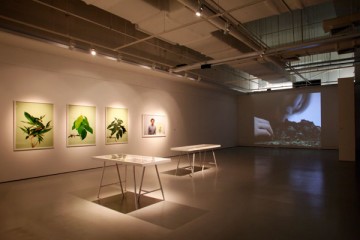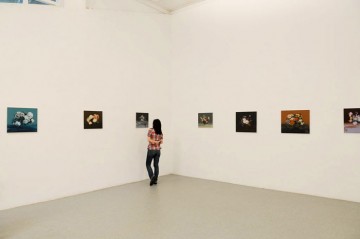Soon after writing my first post for this blog, I realized how unnecessary it was for me to point out that things are different between the States and Singapore. Isn’t that a given? Even Peter in 5th grade would know things are different between Canada and Mexico. That pretty much goes without saying. Also, I have little interest in playing games of “spot the difference” between two pictures. So, what is it about living in Singapore that made me, an American, feel really confused and disoriented? Hopefully at some point, my analogy will be The Man Who Knew Too Much (1956), instead of The Man Who Knew Too Little (1997). In both films, the protagonist is involved in an assassination attempt while “on vacation.” I think the “guest” status applies here, as I consider my own position on this island.
On my way to visit a friend’s studio in Goodman Art Centre, a newly-converted art studio and gallery space, (really nice studios, funded by the National Arts Council, but I cannot apply since I am not a citizen–so I am bitter), I was thinking about funding for the arts here in Singapore. Spaces like this, set up by government funding agencies, are rare in the States. I have seen State government subsidized artist co-ops, but nothing like these large-scale studios for artists, offered at a pretty affordable rate. This is one stark difference between the States and Singapore: Singapore’s government aggressively puts money into the development of art, but to me this seems to be more of an act of compensation to balance out the small private sector. (I myself have already been involved with three shows that are funded by the National Arts Council). I wanted to learn more about how Singaporeans feel about working in this kind of environment; luckily, the friend I was visiting happened to be an artist and curator named Guo-Liang Tan, who recently guest-curated the exhibition We Who Saw Signs at ICAS (Institute of Contemporary Art Singapore). That show featured many internationally-known artists including Ho Tzu Nyen and Adad Hannah.
First, I asked Guo-Liang about his experience writing on art in Singapore, where there is a lack of regular art periodicals. He points out a periodical called Focas: Forum On Contemporary Art & Society, edited by artist Lucy Davis, which had a good run for a year but ultimately met its demise due to lack of funding. He jokingly said that the only people who need art publications are artists. I thought that was humorous but true. In a small country such as this, the small population of artists simply cannot fuel publications centered on art. And it is not a coincidence that the newspaper Strait Times’ art coverage falls under the “Life” section, together with articles on home decoration and holiday travel. Guo-Liang points out that there aren’t enough art writers here, though some, like Lee Weng Choy, June Yap, and T.K. Sabapathy, have been very influential in developing the local art scene. Guo-Liang notes that, given the lack of art periodicals in Singapore, much of the art writing now takes place within exhibition catalogs. This means that artists who are not exhibiting their work publicly are left out of the contemporary discourse. In earlier days, Singapore’s art writers had followed a select group of artists and supported those artists’ practices by explaining them to the public. In contrast, much art writing today seems more impersonal.
I am not a writer, but I think having a publication keeps some kind of narrative continuity within an art community. Not that I am a passionate reader of Art Forum or other Stateside publications, but it’s nice knowing I have the option of picking up a copy. (Good conversation topic as well: “Hey, have you read this and this last week? Nope! I have not, tell me more!”).
Later in our conversation, I brought up the issue of the rather small private sector of the art market. To me, it seems that the government has to do a lot more to sponsor art projects, exhibitions, and collections. Guo-Liang mentioned that compared to the States and Europe, Singapore’s publicly-run spaces–such as museums and funding boards like the National Arts Council–play a much bigger role (relative to the private sector) in terms of exhibiting artists and providing opportunities. It is only after an artist has a show in a museum that galleries and the private sector chime in to take on the artist’s market development. Therefore, generally speaking, it seems to be a flip-flop from the Western norm, where artists first show in galleries and then are collected and exhibited in major museums. I hate to generalize such a thing, but the difference is pretty obvious here. I don’t have a particular problem with government money aggressively funding artistic endeavors, but it is possible to make the argument that since the main source comes from a rather conservative government body, it is likely that artists might miss the opportunity to use art as a tool of criticism. Guo-Liang told me that right now, Singapore lacks a more balanced private sector containing more adventurous collectors and gallerists–someone with vision, who can guide contemporary art in a certain direction. He said that Singapore’s government is very good at installing infrastructure for the arts, but perhaps sometimes lacks the personnel to operate it.
I took this opportunity to ask Guo-Liang about the Gillman Barracks, which is due to open next year. There is not that much news available yet, only some general information and some funky illustrations of the plan. Guo-Liang explained to me that Gillman Barracks will be an art district funded by the Economic Development Board (as well as the National Arts Council) to house local and international galleries. It will also feature an art research center. I am a bit skeptical of it, but Guo-Liang seems quite used to the fact that government takes the lead in doing things similar to this. For me it lacks a certain organic quality. An art center installed by the government which would be run by the private sector sounds amazing, if it works. But what happens when a visionary gallery curator comes along and decides to show more sensitive material addressing issues of religion, race, politics, or homosexuality? Would the censor boards chime in and start enforcing stricter rules? There seems to be too much hand-holding. But on the bright side, Guo-Liang reminded me that having more internationally-established galleries opening in Singapore will eventually push the local galleries into maintaining a higher standard. I suppose competition is good, even in places as weird as the art market.
Ah, censorship! Okay, this is where I got kind of worked-up. I brought the recent 2011 Singapore Biennial censorship issue into my conversation with Guo-Liang. (It is rather old news now, but basically Simon Fujiwara’s installation Welcome to Hotel Munber was closed down during the Biennial due to its homoerotic content. Please read more about it here and here). Again, Guo-Liang didn’t seem surprised by the decision of the Museum to shut down the installation. He seemed more bothered by the fact that the media is having “amnesia” about art censorship. It seems that every time an art work faced censorship issues, the newspaper and online media would ask the same questions: “Is this art? How far is too far? Does the public have the power to control what is shown in public?” It is always the same questions, and it never goes further than that, he said. It seems to me that this is another good reason to have art periodicals; counting on the daily newspaper–which deals with more of the “happenings” of the moment–is not constructive. In the hyper-informed world of today, people tend to have shorter attention spans as well as fuzzier memories.
So here is my big, 12-gauge shotgun of American bias, which I think most Americans would agree with: it is necessary to have artists pushing the boundaries of society and culture. Artists, like all responsible citizens, should criticize the government when they are required to, because it will make the governing body a more responsible one. A government that fails to take criticism is ultimately a weak one. My friend Michelle Lim told me about an art show by MARUAH (Working Group for an ASEAN Human Rights Mechanism, Singapore) addressing human rights and death penalty issues which was closed down by the Media Development Authority (the censorship board). Strange! Bizarro World! One would think an art show about human rights would get a free pass!
Guo-Liang said that we have to take into consideration the fact that Singapore is a young country (only 45 years old); the development of an art audience still lags behind that of Western nations. Also, all countries have their own unique taboos, like child pornography or certain religious issues in the States. In the case of Singapore, it is images of gay pornography, since the Singaporean constitution bans homosexual relationships.
Before I left, I asked Guo-Liang whether he has any shows coming up in the near future. He gave me an answer I did not expect. He said that he has been apprehensive about showing his work in public thus far because he feels that his paintings will seem somewhat out-of-context to a local audience. He explained to me that, since his formative years studying at Goldsmiths, University of London, his symbols, points of reference, lexicons, and vocabularies are mostly nested in the history of Western painting. I told him that I’ve noticed that a lot of young Singaporean artists are trained overseas, in London, Germany, and Stateside, and asked him what it means to the art scene here, that a good portion of artists have spent their formative years abroad? Guo-Liang told me he thinks there is a certain international feel to the works that are made here. It is very obvious when compared to neighboring Southeast countries. I asked him if that has a fragmentary effect on the discourse here, and he responded that maybe it does, but it is also a very liberating thing.
I think constantly about my own work’s relationship to this abstract idea of “an audience.” When I moved from the States to here, I knew I would have to make some adjustments to my practice. I don’t believe that I am making art for Singaporian audiences per se, but I do have to re-think how I communicate through language and symbols. I need to think about this more: I imagine, in an abstract way, when we stare at our imaginary audience, we see ourselves. And each art piece starts at this internal moment, when we ask our reflected selves, “what do you want?” But it just so happens that the two selves speak at the same time…then someone yells, “Jinx!” It is rather confusing, but kinda nice that way. I guess what it comes down to is that Singapore, like many other metropolises around the world, has influxes of young artists coming from elsewhere, and it takes a long time to figure out a common way of understanding.





